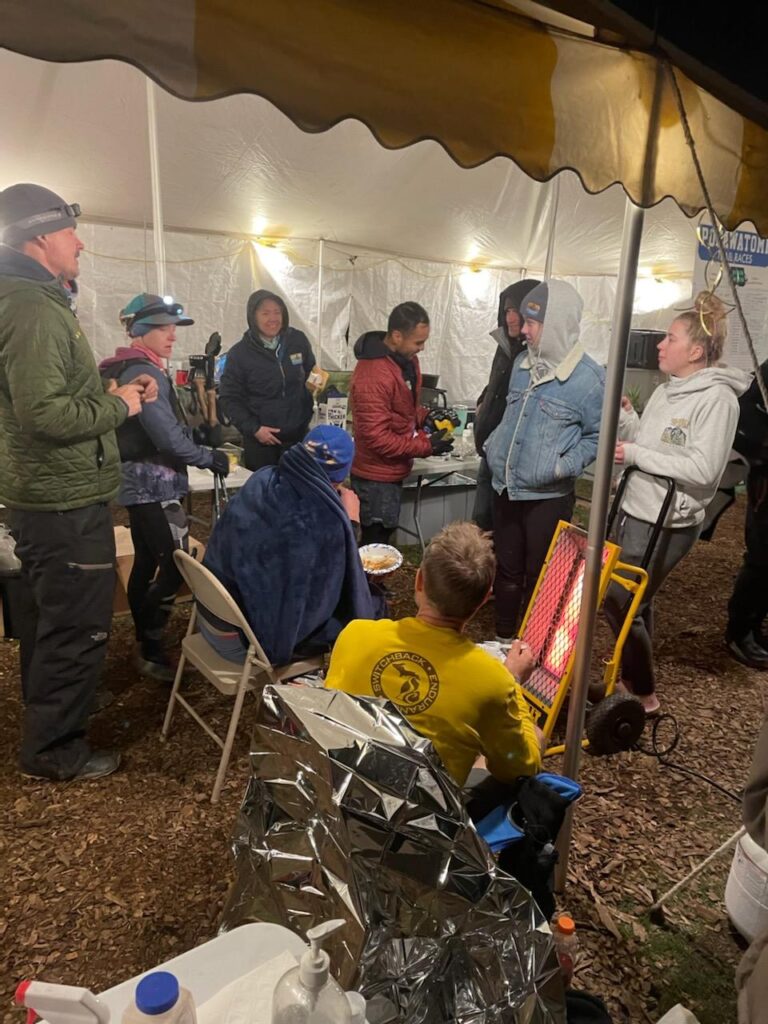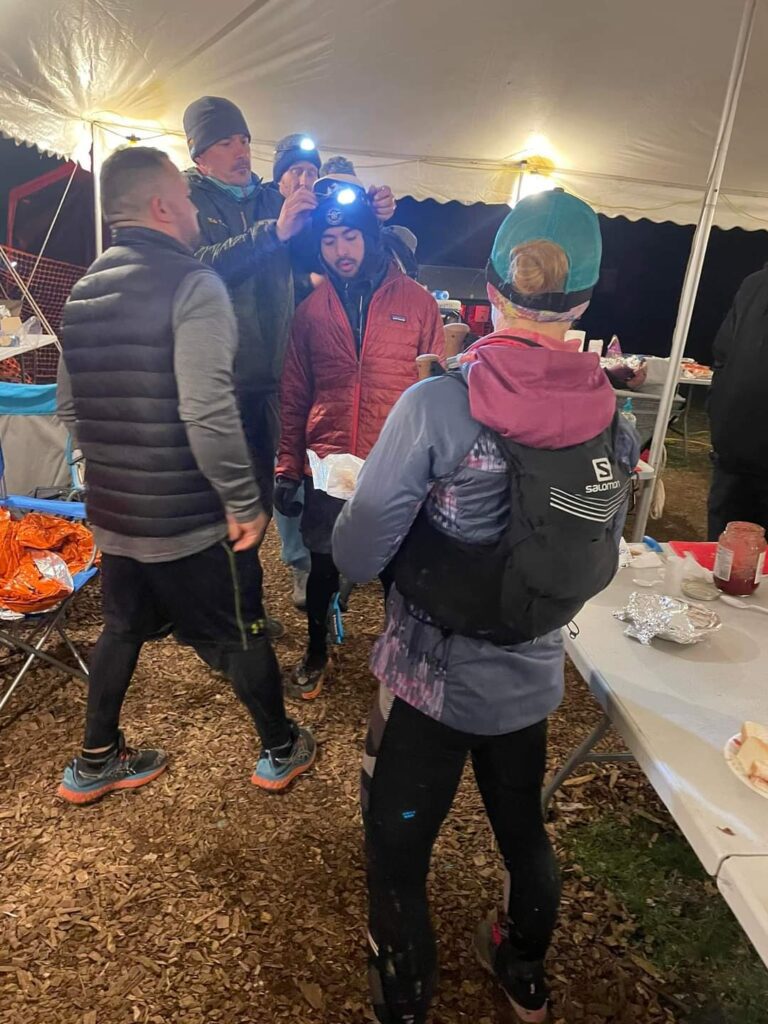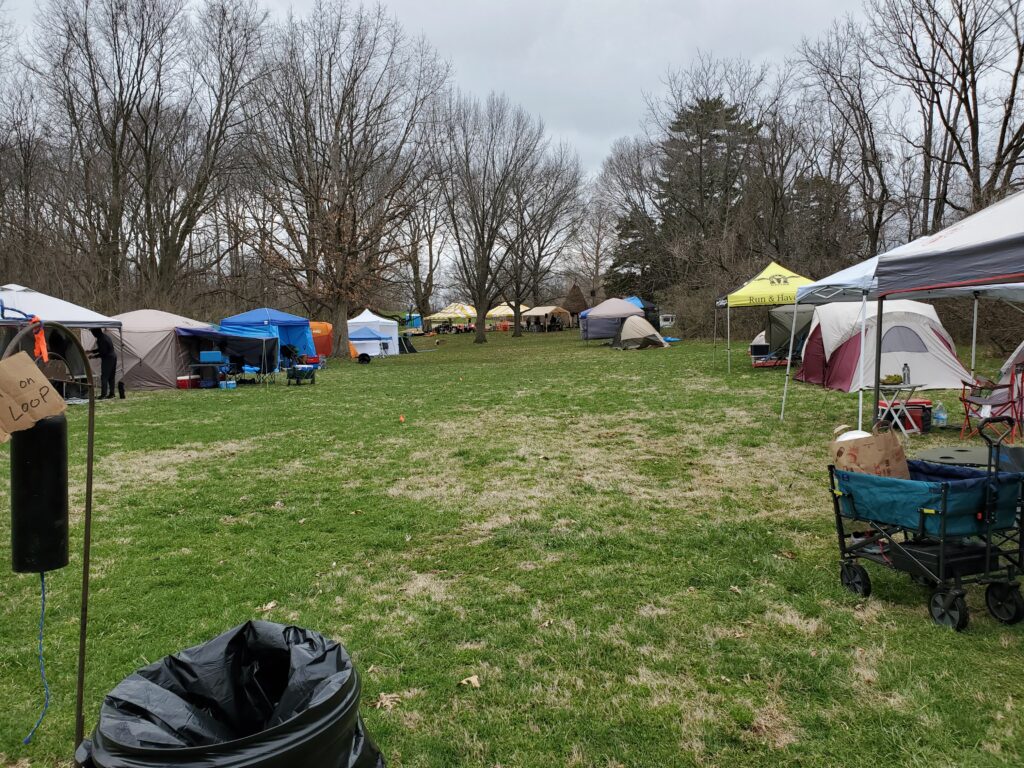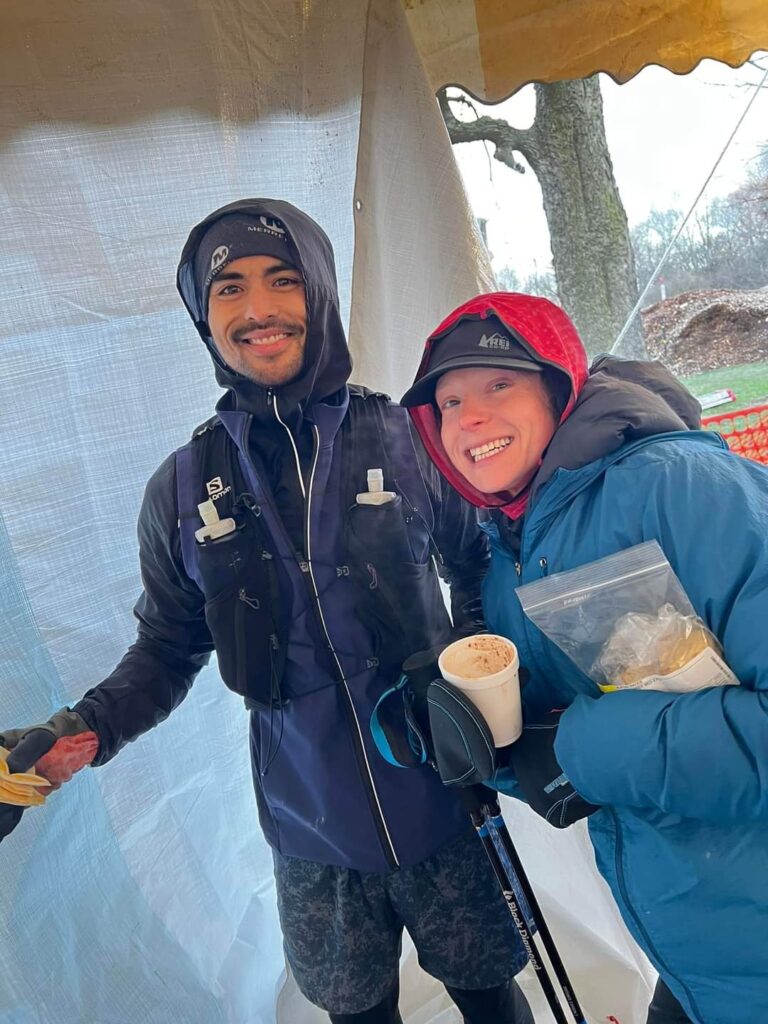

By Morgan Mader
Inside the tent, it's cold and humid, but tolerable. I’m waiting on our Kelty loveseat camping chair. My pack is filled with fluids and snacks. My trekking poles are on standby next to me. I've been awake for over 33 hours—having finished my own 50-miler yesterday—and I am about to pace my husband, James, for the last 20 miles of the Potawatomi 150—honestly, a dream come true.
The Potawatomi Trail Races is an annual event held in Central Illinois, and arguably one of the most popular ultras in the state, attracting a wide variety of runners. Central Illinois, in April, is always a mixed bag of weather. One year you may experience unseasonably warm, sunny spring weather, and the next you'll be running in ankle-deep mud, soaked by either rain, snow, or hail. With a challenging, but pleasant, 10-mile loop, event distances range from 10 miles up to 200 miles.
Sitting alone, shrouded in our oversized camping blankets, I flashback to two years ago. It took a lot of convincing to get James to concede to tackling only the 100-miler for our first visit to Potawatomi. As fate would have it, the race was canceled that year (not an uncommon occurrence in 2020) and everyone who had registered were offered free race distance upgrades for 2021. That was all it took for James to go all in for the 200 miles.

In 2020 we were just starting our second season of ultra-races. We barely knew how to run 100 miles. Now we expected to double that distance. In the end, neither James nor I were prepared to tackle the complications that come with executing a 200-mile race, and James pulled the plug 100 miles in.
Back in the tent, I laugh to myself as I ruminate on how James split the difference for this year’s race, committing to the 150-miler. A couple of years ago, he won Illinois's Temptation 200 (which, in reality, clocks in closer to 124 miles). What're another 26 miles on top of that?
Ten hours ago, James rolled into camp at mile 90. Having long since finished my 50-miler, I had transitioned to crew. I filled his bottles and pulled out his nutrition for the upcoming loop.
"Morgan, I need you to get me pacers."
I cocked my head to the side, slightly taken aback. James never requested pacers.
"Do you want them for the last 5 loops?"
We were walking away from the tent at this point, mostly on autopilot, picking up speed as we approach the trail beyond.
"Yes. Make it happen."
And off he went. I had 2 hours to come up with pacers and a plan.
Potawatomi is a prime example of how folks in the local ultrarunning scene view racing and community. While my task seemed tall, I knew that James was well-liked within the community and people would likely show up for him.
One question James and I are often asked is, “How do you prepare for these distances?” I often wonder what they’re looking for—what kind of answer they’re hoping to get—a simple response with a simple solution or some kind of elixir for success? This was James’ first attempt at a distance greater than 124 miles. His solution was to run a 500+ mile month in March. He and I have gone back and forth on whether he was overtrained for the 150-mile race in 2022. By standard definition, overtraining traditionally encompasses both a physical and mental state of being. James was emotionally ready to take on the 150. He felt fresh and energized for the experience. But we’ll never know whether his leg fatigue and niggles during the race were due to the heavy training or were simply a result of running 150 miles of trail over a cold spring weekend. Only future attempts will reveal the answer to this question.
With James’ pacer request at the forefront of my mind, I immediately darted over to the tent area, where our friends, the Goodmansons, had set up camp. I knew without a shadow of a doubt that they would be able to point me in the direction of some willing, on-the-spot pacers. As luck would have it, one of James’ good friends was sitting there and instantly volunteered for a loop. He also volunteered another pacer, so James was set for miles 100-130.
However, it was going to be up to me to pace him the last 20 miles.
Now, to some, that may sound like a piece of cake (and don’t get me wrong, I love cake!). The way we in the community often talk about distance, it makes sense that someone outside the community might think that twenty or thirty miles is nothing to us.
That’s not always true, though, especially when you’re talking about trail racing.
Ever since the start of our ultrarunning careers, I’d had a deep desire to pace James. Once it became clear that he was an exceptionally strong runner who could hold a solid pace well into 80-100 miles, I’d assumed this was most likely a pipe dream. Yet now was my chance to see if I had what it took to run with him and provide the ultimate form of support in the process. This would be no small feat. I had already run a very successful 50-mile race and essentially paced a friend of ours through every step of his first 50-mile finish. Since then, I had transitioned to crew, sleeping very little in the meantime. Additionally, by the time James would be ready for his final 20 miles, it’d be nighttime, which is traditionally the most challenging time to run. It’s dark. It’s cold. By then I’d have been awake for who knows how many hours and James would be going on more than 35 hours of non-stop running. This was a BIG deal.
Never one to take anything lightly, I was looking forward to the challenge. I would finally get to see firsthand how James handled extreme distances. Usually, I get a quick kiss and a wave as he laps me on a looped course, but now I’d get a sense of what he was thinking and how he responded to adversity. This was going to be 20 miles of grit, run in the middle of the night—not something we were unfamiliar with, as it’s often part of our training routine. There was something natural and serendipitous about us wrapping up this race together, alone in the woods, most likely as the sun was coming up.
If that isn’t romantic, I don’t know what is.

When James finishes his tenth loop, I’ve got his first pacer ready to go, which energizes him. He purposefully moves through our campsite, switching out handhelds that I’ve topped off with Fluid, his preferred electrolyte supplement. James stuffs some Spring nutrition down the hatch and then he’s off, his friend in tow.
With him gone again, I slowly start getting ready for my pacing run. The weather has warmed up, and the sun is out. I begin to go through my thorough pre-race routine. First, it’s the Normatecks. We invested in both the hip and leg attachments which have been extremely valuable in promoting leg recovery. If you train as much as we do, it’s a great investment. I lay on our zero-gravity chair going through each session—first the hips, then the legs. I cover myself with a blanket, because it may attract attention, but this is also an opportunity for me to relax, read, and even take a short nap. Once wrapped up, I start prepping my pack, hydration bladder, portable nutrition, trekking poles, headlamps, and running gear.
When James arrives at camp again, he takes a bit more time at our tent. Still, he is efficient and focused. It’s nothing but love and support, then he’s off again, this time with a different friend.
James is hungry this year, it’s obvious.
Last year’s DNF of the 200-miler taught us some valuable lessons. Races don’t work linearly. Planning and executing a 100-mile race is one thing, attempting to double that is something else entirely. The challenges and pain are increased exponentially. Being able to navigate things like poor weather, foot and gut health, and gear complications, all while maintaining a positive headspace, is absolutely essential. Admittedly, I was not prepared to support James for the 200-miler in 2021. Could I have fumbled my way through it? Of course. But it would take crewing James’ 150-miler in 2022 for me to learn what it meant to be truly excellent crew.
It’s late afternoon, transitioning to early evening. I’m keeping track of James’ average loop times and know when to expect him. He has one more loop before I’m on deck. I see James coming out of the woods into the clearing, following the long single-track trail that runs toward the start/finish area.
For as long as I’ve known James to run, his gait has been imprinted in my brain. I could recognize him running in the dark from a quarter mile away. I know when he looks fresh as a spring daisy, and I know when he may be experiencing some niggles.
As he emerges from the woods, I can see the miles working away on his body. He’s run 120 miles, and he’s sleep deprived. James trots into our campsite saying he is cold. I immediately fly into action, grabbing his jacket and bundling him into two oversized blankets. Suddenly, James does something unexpected. He pulls the blankets up over his head, becoming fully encompassed within them. As I watch, I hear a soft, almost inaudible, choking sound—James is holding back tears. I crouch under the blankets with him. He’s quiet now. I slowly rub his back. I know that just these brief few minutes of comfort can be enough to relieve his pain and get him focused again.
To mitigate his cooling down, we decide that James will leave camp with a down jacket that he’ll wear for the first mile. At that point, the trail loops back around near the starting area and I’ll be able to pick the jacket up from him after he’s warmed up.
“Okay, James, it’s time to get back out there. You’ve got one more loop, and then I’m going out with you for the last two.”
He comes out from under the blankets and stands. A small army of people has gathered to assist James with whatever he needs. They too are now invested in his finish. This is the community I’m talking about—people coming together to help each other achieve unbelievable feats of human prowess.
James and I move towards the starting line, left alone to enjoy a brief personal moment. He looks at me as we’re walking: “Morgan, I’m just so tired. I’m so tired.”
My heart cracks slightly. This is one of the hardest parts of ultrarunning. I know James is looking at me—right now, at this moment, having run 120 miles—and is begging me to let him sleep. I also know—right now, at this moment—that he’s also begging me not to let him sleep. He’s begging me to keep pushing him forward. When you love someone, you are all too familiar with the desire to prevent them from experiencing pain. That part of me wanted to make it stop, to give him some rest. But I know James. My role, then and there, was to be the solid, unwavering beacon of light ushering him forward toward his ultimate goal of finishing the race. There would be no stopping. There would be no sleep.
“I know you are, but you have to keep going. You can keep going. Just one more loop and we’ll finish this together.”
The down jacket is on him. He’s holding a warm cheese quesadilla. James looks at me, turns to look down the trail, then looks back at me. I kiss him on the mouth, then on the cheek and whisper, “Go get it.”
As he turns to trot down the trail, pacer by his side, my heart, which had been on the verge, fully breaks. The tears come quietly. I can’t let him see me. I chastise myself for crying but recognize that it’s healthy to let it out. For the final 20 miles, I would have to be tough as steel.

It’s dark now, after 10 pm. I’m sitting quietly in our tent; my pre-race ritual complete. I threw in a Theragun session and applied Amp to my legs—doing what I could to make this feel like an entirely new run. A full day removed from my race, I feel like it almost never happened. But that could just be nerves. I’m wired, but laser focused.
Suddenly I hear a familiar voice outside the tent.
“Hey Morgan, Jeff says that James should take a nap before he heads out for the next loop.”
Our friends, the Goodmansons, are relaying me a message. Jeff has seen James on the trail and feels like he needs sleep. I listen, then pop my head outside the tent to consult with a friend who is also crewing for James. I’m always open to receiving feedback, but this suggestion gives me pause. How do I best address it while keeping an eye on the end goal? No one knows James better than I do. I can’t let that slip my mind, especially at this crucial turning point. We decide to split up. He will go towards the trail opening and intercept James, then report back to me James’ own opinion as to whether he should continue.
I don’t have long to wait. I’m back in the tent, trying to stay as warm as possible, the temps have dropped back into the 30s again. All is quiet outside. Then, like a boom from across the woods, I hear, “MORGAN, HE'S NOT STOPPING!”
Immediately I get goosebumps (and still do thinking about it today). The sheer grit and determination it takes to reject the offer to stop and rest is astounding. I’m up. My pack is on. Trekking poles are in my hands. Headlamp is on. The tent is set for a quick transition when we return for our final loop.
James moves past our tent. I’ve bagged up hot food for the trail. He’s being attended to by a slew of friends. I lose track of time—unaware of how long the transition takes—and then we’re off down the trail together.
Once we make it down the first long descent, the trail evens out into prairie. It’s a classic Illinois race. My goal is to be encouraging and upbeat and keep him moving. I start in front. It’s painfully evident that James is tired. I encourage him to run for 10 steps, then we walk. I encourage him to run for 15 steps, then we walk. It goes like this for a while. I would be lying if I didn’t admit that much of this was a blur. It’s pitch black beyond our headlamps. With sleep deprivation, the scenery appears strange. You can recognize landmarks and turn them into benchmarks throughout the loop. James entertains this for a while, explaining to me what our next benchmark is as we move through the loop. We move through creek crossings—the water up to our knees—down narrow single track, up steep ascents that offer a rope to assist the climb. James’ ability to run downhill has been whittled away. He can still run and climb, but it’s clear the downhills are painful. I continue vocalizing positive thoughts, but after a while, James is not interested in conversation. It also becomes clear that he prefers me behind him, not leading. This is fine with me. It’s not my race and I’ve never paced him before.
Having brought my phone with me, I call our friend who is waiting at the tent. I update him and tell him which food items he should have ready to go. This has turned into a seriously coordinated event, and it’s exhilarating.
The end of the loop arrives sooner than I anticipated, and my legs feel great. This is astonishing to me, and I’m grateful that they’ve held up.
James has 10 miles left. He’s about 2.5 hours ahead of the next competitor. This race is his for the taking, but we have to keep moving. At the start/finish tent, he’s standing, eating a cheese quesadilla. Four people are fixing him up with a winter hat, food, and fresh bottles. His eyes are closed and I’m convinced he’s fallen asleep standing up. When we take off again, James is disorganized on the trail, almost as if he were drunk. It occurs to me that he never really needed anyone to pace him. I am strictly here to make sure he is safe.
Eventually, James steadies himself a bit. This far into the race, muscles and neurons aren’t firing as they should be. A clumsiness is more apparent in his movements. About two miles in, James’ headlamp is dimming. This is concerning but not an outright issue. I plan on changing his batteries at the next clearing. It’s ghastly quiet—the only sound is our shuffling steps on the woodland debris strewn over the path. It’s cold and still. I catch myself focusing heavily on my feet, aware of the roots and leaves we’re moving through.
Without warning, James falls.
He flies forward, owning the fall Superman-style. His trekking poles shoot off—one to the right, one to the left. We’re in a clearing, approaching where the Totem Pole aid station used to be. Now the area is turning into a soft grass field. There’s not much here to trip on, but James found what appears to be the smallest of twigs and it completely obliterates his balance. He goes down. I’m standing behind him analyzing for injuries. He rolls over on his back, and it’s clear he isn’t injured—a total relief.
James lies on the grass staring up at the clear, spring night sky. It’s completely silent. I’m not even breathing. I look into James’ eyes. They’re wet and shiny, reflecting the moonlight. I can’t ignore the thought that he is about to cry. If he does, it will just about shatter my heart. Without thinking, I bend over him and firmly say, “Get up. Get up, James.” His eyes shift to look at me—registering my presence for the first time since he hit the ground—and they are suddenly clear. I see a distinct shift occur, almost a click. My hand shoots out. He grabs my hand, and we use our collective strength to get him to his feet. James stands there. We’re eye to eye now. I encourage him to take a moment to organize himself. I give him my headlamp and take his dimming one.

No additional words are spoken. James reorientates himself and starts up again, only now his pace has quickened. We keep our trekking poles up as we run through the darkness. It’s after 3:00 am now, the witching hour. We continue along the trail, James taking fewer walking breaks.
At Heaven’s Gate—an exceptionally runnable mile-long loop—my legs start to ache. I curse this for happening now. Not wanting to ask him to slow down, I talk myself through the pain. It’s my turn now to see what I’m truly made of. I don’t want him to have to drop me.
I will not miss him finishing. I will push through my fatigue. I will be there for him.
I am not exaggerating when I tell you that James’ lead-up to finish is the most unbelievable thing I’ve ever seen. James was a man possessed. He ran the last 8 miles. We didn’t speak a word. We used our poles on the descents, but when it was time to run, I’d watch them choke up in his hands, and I’d mimic him, knowing we were about to take off. We were like a well-oiled machine. I’ve never felt more connected with another human being than during these last 2 loops. There was only one goal. One. It didn’t take words; it didn’t take daylight. It only required our minds to be cosmically interlinked in this one unified pursuit. Never have I run an easier 20 miles.
As we approach the final uphill, anticipation is vibrating between us. James bolts up the hill and I use everything I have left to keep up. As we trot around the final bit of wooded trail, we pass the cowbell, and I ring it with the extreme might of what an army would use to announce the presence of the enemy.
It’s 5:30 am. I don’t care. I want to wake everyone up.
“JAMES SOLOMON, 150-MILE FINISHER COMING THROUGH!” I boom across the campsite.
Cheers erupt from the darkness, the finish line lit up like a beacon of salvation. We fly to the finish, towards a celebratory and triumphant reception.
James is immediately met by the Race Director, who hands him his awards for first place. Finishing in 41 hours, James hasn’t broken the course record. Still, he ran hard enough to bring us home a victory. Friends, aid station volunteers, and spectators crowd around us for hugs and photos. I look at James. It’s the first time I’ve seen his face since he’d fallen. His eyes are alert, his smile infectious. He doesn’t look like he’s just run 150 miles, without sleep, in the woods, in the cold. And it occurs to me that James might have more in him—that he could have pushed himself even further. I see it now with my own eyes—clear evidence that we’ve only just scratched the surface of his potential.

Photos provided by Morgan Mader
